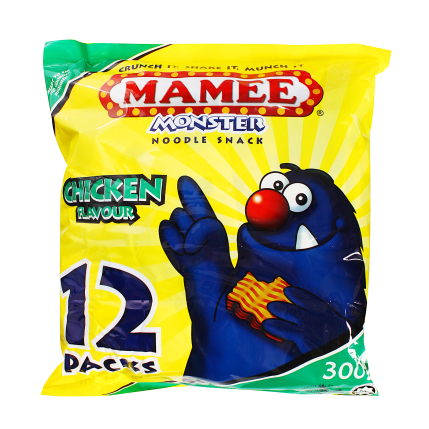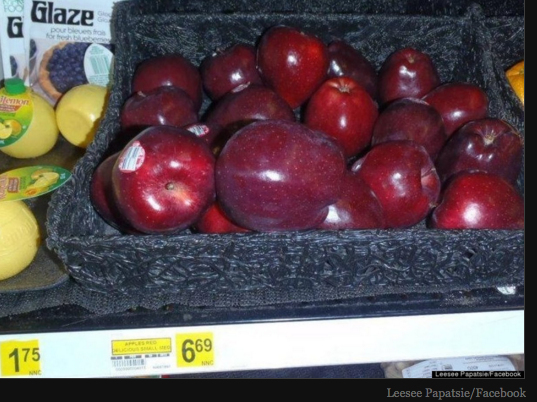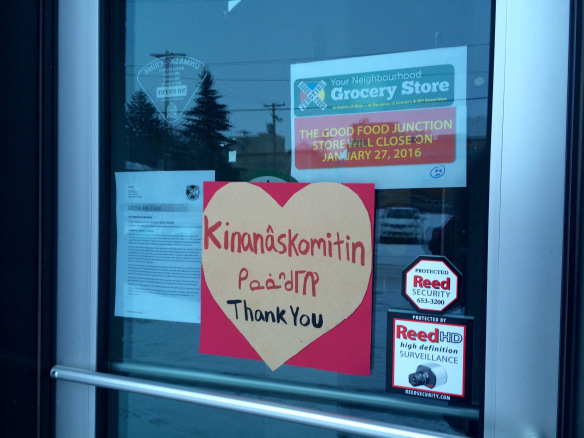Like this article? rabble is reader-supported journalism. Chip in to keep stories like these coming.
One of my earliest memories as a child is of sour fruit juice staining my face at my YMCA gym class.
You may think this face was evidence of civil disobedience to come, but I swear, it was the bitter juice.
A lot of my memories of growing up, like most people, I imagine, are about food and eating.
I remember having smoked salmon jerky in White Rock, B.C. with my Maori grandfather. I swam in the cold ocean with my mom and we laughed as we watched grandpa on the beach, picking clams out of their shell and sliding them into his mouth, raw.
I remember, later that day at dinner, sitting at the immaculately set table of my grandfather’s new girlfriend. She had privately asked me to call her “grandma” even though I had just met her. I was nervous and tried to sit still and eat properly, but my hands shook and I spilled my juice all over and ran away from the table crying. Being near the starchy, sterile things in her house made me lose my appetite.
She gave me a bag of castoffs; well-worn clothing that her own precious grandchildren had outgrown. I tried to act grateful while she showed off pink shirts covered in glittery silkscreened horses (her grandchildren did equestrian, because of course they did). I remember Grandpa made a joke (???) about how horses were just “good eatin’,” to make me smile.
As we packed up to catch the Greyhound back to Saskatchewan, I heard him quietly ask how Mary (or Nana, as I knew her) was doing these days.
My mom told me on the way home how he had never really gotten over her.

(Nana gave me my first donut behind my mom’s back, because that’s what nanas do.)
I remember beef soup at elementary school feasts, and learning to serve elders first; but surreptitiously wondering with a rumbly belly, how old I had to be before I was an elder too. I remember KFC boxes containing our special monthly “hot lunch” of choice. We took a class trip to The Hague, Saskatchewan, where we brought bannock and the Mennonites served us dark red beet borscht.
My mom worked in the kitchen of my school, so I went in with her early every morning to prepare breakfast and bagged lunches for the low-income lunch program. She worked as a cook until I was born, is still a great cook, and likely harbours secret shame from that time I tried to heat a frozen pizza and forgot to take the cardboard off the bottom.
We were relatively stable at times, so I would share the peanut butter and saltine sandwiches my mom would pack, along with containers of olives, which a lot of kids in the lunchroom had never seen before. (A boy I liked then teased me that I stunk like the olives, but I decided I liked the olives more, anyway.)
I remember a teacher telling me, “your mom always packs the nicest lunches for you, she must love you very much”, not understanding how that must’ve felt for the kids beside me. The ability of parents to pack homemade lunches was not about how much they loved their children, but the legacy of governments who have never wanted Indigenous children fed.
I remember our trips to the food bank because the kitchen job wasn’t enough. I remember what the distribution room smelled like and spending a lot of time watching the floor as we waited in line. I remember waiting at the door and making my mom carry our hamper and the bag of apples or oranges on her own, because I felt ashamed. A few things stick out in my mind from the hampers: sometimes suspect cans, a litre of milk, and these bright yellow packages of ramen noodles with a colourful monster on the front that I’ve never seen for sale outside of this part of town. I know then, just as now, volunteers do the best they can with little funding and few donations.

I remember, one year, being “adopted” by a wealthy white family through a Saskatoon holiday program. They came to our house on Christmas day and gave us more groceries than I’d ever seen all at once and toys for me (a brand-name Barbie!). I remember this idyllic family of four — a mom, dad, a daughter, and a son — all blond with giant toothy smiles, standing inside our doorway in their snow boots, while we thanked them profusely for their generosity.
I remember growing up and being referred to as “less fortunate” and “at-risk”.
I remember last week in Montreal, finding myself at $75 business dinner I couldn’t afford on my own, but was too afraid to say otherwise. As a consequence, I spent most of the time thinking about the roots of food insecurity on this land.
The Inner City, The North, and Food Insecurity in Kisiskâciwan (Saskatchewan)
Inner-city misâskwatôminihk (Saskatoon) is known locally as “The Heart of the City,” or it was, until the gentrification process kicked into full swing and “Riversdale Revitalization” took over. The area of the city where I live, Pleasant Hill, is on the edge of gentrification, and the poorest area of the city. It is predominantly Indigenous, with a particularly high Métis population.
There are some great people in the city who have already critiqued discourses of gentrification disguised as revitalization: from the desire to “introduce culture” to a place where settlers see no culture or history of worth, to the hipster callousness of a cafe on 20th street whose Wifi password is probably still “ItsAllGoodInTheHood.”
The Good Food Junction
On January 27, the only grocery store that sold fresh produce within a 10-block radius in either direction of my house was closed after three years of operation.
The Good Food Junction was a hard-won co-op project at Station 20 West, the same building where we held the first Idle No More teach-in.
Before the Good Food Junction went in, I remember the pilgrimages of people in our neighbourhood who would walk down the busy, treeless stretch of concrete, 20th street, in the hot sun or the freezing winter. Thirty minutes to the Extra Foods and 30 minutes back, this time, carrying groceries to hopefully last for the week.
Opening the doors of the Good Food Junction was a struggle. The NDP government had dedicated $8 million that would’ve funded the store, but Brad Wall’s Sask Party government withdrew the funding as soon as they took office. The community managed to raise it anyway but it took much longer.
Yes, this is the same Brad Wall who recently responded to prison hunger strikes in Saskatchewan by saying, “if you really don’t like the prison food, there’s one way to avoid it and that’s don’t go to prison.” This, in a province where 16 per cent of the population is First Nations, but constitute 80-90 per cent of the prison population.
It is not a coincidence that areas with high Indigenous populations are the areas deprived of access to food and health care. At its core, this is an issue of maintaining the dispossession of Indigenous people and the legitimacy of Canadian control; an attempt to destroy the nations and legal orders that we hold in our blood, our muscles, our stomaches, our minds, our mouths.
Driving up to the north in January, I talked with my friend Mylan about how kisiskâciwan is considered terra nullius by so many Canadian settlers who do not understand that these lands feed and house millions of people — from crops, to meat, to the logs taken from clearcutting and shipped around the world — and yet, on these lands of our ancestors, we are starved.
My response to Brad: if you don’t want us to stick our sassy tongues out at you, stop contributing to Canada’s history of starving Indigenous people while you dine on stolen land and resources.

Media coverage of the Good Food Junction has been ahistorical. Headlines refer to the closure (if they refer to it at all) as a store failing because of its high prices. If the paper was progressive, it might mention that the prices were high only because the small, independent grocery store could not afford to keep up with massive discount retailers in the vicinity like Giant Tiger (owned by The North West Company) and No Frills (owned by Loblaw’s). The North West Company also owns North Mart, notorious for price gouging northern residents, largely Inuit.

I’m not interested in narratives of “neglect” as the cause of poor health in the North, which are everywhere following the shooting in La Loche; at least not without digging deeper. Negligence, yes. Broken legal obligations, yes. But this was only a problem once poverty, violence, and food insecurity were created not as a consequence of Canadian neglect, but rather, by colonial theft and the willful destruction of ways of life that sustained us for centuries.
Being left alone in the first place is one of the best things that could’ve happened for Indigenous people and for this land.
I remember Conservative MP Leona Aglukkaq’s comments that Indigenous people don’t need food security because we can go out and hunt. (My tastes aren’t as adventurous as my grandpa, so I’m not super into the idea of hunting pigeons on 20th street). She made these comments while Indigenous people around the country spoke about the irreversible pollution of clean water streams that could be scooped from hands to mouths a mere decade ago; the appearance of cancerous sores on once delicious and plentiful fish; the difficulty of trapping and hunting as winters disappear and migration patterns shift.
ka âhkameyihtamihk: persevere
The closing of the Good Food Junction is a loss in misâskwatôminihk, but it is not the end.
There is a community garden a few streets from my house.
There are revival projects to teach about Indigenous foods.
There are people brave enough to refuse to eat in protest of unsuitable food because they know they deserve better.
This is my love letter to all the wild-tongued dreamers in kisiskâciwan; those who built the Good Food Junction, those who are fighting for inner cities, and the North, and on traplines, and in prisons, and on any land where others are growing rich on our hunger.
When it feels impossible, remember: there is nothing more radical and threatening to their greed than the dream of our communities well-fed, healthy, and strong.

Erica Violet Lee is Nehiyaw from Saskatoon, Treaty 6 territory and Métis homeland. She is a philosophy student at the University of Saskatchewan, an activist and a self-described “Indigenous feminist.”
This article originally appeared on her blog, Moontime Warrior. It is reprinted here with permission.
Like this article? rabble is reader-supported journalism. Chip in to keep stories like these coming.



